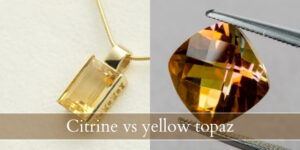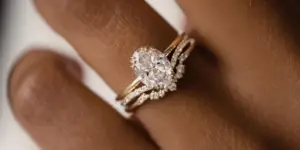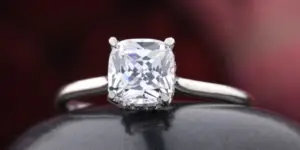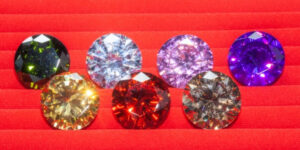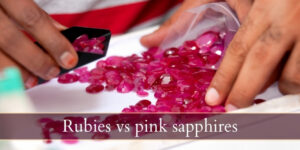Purple gemstones are some of the most mysterious gems on the planet, and there really aren’t that many to choose form. This makes them even more interesting as every little hint of violet or lilac will grab you attention instantly. So what if you want to wear a purple gemstone ? You’re likely thinking of amethyst. But is there another, possibly better alternative ? Some have suggested purple sapphire.
So let’s compare amethyst and purple sapphire, see which would work better for the jewelry you’re thinking of, and any other options you may have available.

Purple sapphire vs amethyst
Purple sapphire is a far stronger and harder gemstone than amethyst, so it’s much better for daily wear than amethyst. Amethyst also tends to lose its color when exposed to direct sunlight for several weeks, while purple sapphire retains its color even after repeated sunlight exposure. And finally amethyst sells for far less than purple sapphire, so it would be a more affordable gemstone and easier to replace if you ever needed to because purple sapphire is harder to find than amethyst.
Both gems show great purple colors and choosing just one is not easy. So let’s take a look at each gem in particular, and then compare the two.
What is purple sapphire ?
Purple sapphire is a variety of sapphire (corundum) that owes its purple color to trace amounts of chromium (which makes ruby red), and a combination of titanium and iron(which makes sapphires blue). Purple sapphires are just as strong and impressive as blue sapphires but simply have a different color.
What is amethyst ?
Amethyst is a variety of quartz, the purple-violet variety to be very specific. This gem owes its purple hues to trace amounts of iron, and you can find it in various shades from the palest lavender to the deepest purple, with undertones of either red or blue.
Amethyst was originally one of the 5 cardinal gemstones, along with diamonds, rubies, sapphires, and emeralds, and was regarded as a precious gem. But since a very large deposit was found in Brazil about a century ago, it has become much more common and lost its cardinal title.
Now let’s take a look at the comparison between purple sapphire and amethyst, see how they compare.
1. Purple sapphire is a harder gemstone than amethyst
Purple sapphire is a stronger gemstone that amethyst, and this matters a lot when deciding how to mount the gemstone and how to wear it. A purple sapphire has a Mohs hardness rating of 9 out of 10, which is very tough. Moissanite scores a 9.5 while diamonds score a perfect 10, for comparison. So a purple sapphire will hold up to wear and tear perfectly and will not show any scratches until you scratch it with something stronger, like a diamond.
Read also: Green Sapphire VS Emerald
Amethyst is a far softer gemstone, scoring a 7 on the Mohs hardness scale. This is because amethyst is a type of quartz, which is a fairly soft gem. We don’t recommend wearing amethyst every day, as it will scratch and chip far easier that purple sapphire. In theory all gemstones at 7 or above on the Mohs scale are fit for daily wear. But in practice, the lower the hardness the faster the gem gets cloudy and the more trips you have to make to a jeweler for a re-polish.
So in short, purple sapphire is a far more durable choice for a purple gemstone, especially if you want to wear the gem every day, such as an engagement ring or a very sentimental pendant.
2. Amethyst may lose its color in direct sunlight
An important factor for amethyst’s color is radiation. Amethyst gets its color from trace amounts of iron, and its builds up color as the gem soaks up the radiation in the lower levels of the Earth. Once it hits direct sunlight, it will start to lose its purple color because sunlight is a form of radiation as well. It bleaches color from most materials.
So if you do want to wear amethyst we recommend you restrict it to evening wear, when there is no direct sunlight to fade it, or only occasional wear when it won’t face constant sunlight for several weeks.
Purple sapphires does not fade in color as its color is mostly derived from heat and pressure, and less from radiation. So its color will withstand direct sunlight and makes it fit for daily wear.
3. Purple sapphire is far more expensive than amethyst
Price is always important when discussing gemstones, and here purple sapphire is going to burn a small hole in your pocket. A purple sapphire sells for about $550 per carat, for an eye-clean, medium-tone gem. The more vivid the color, the higher the price. This is definitely one of the more affordable sapphire versions, as the blue ones routinely go past $10,000 per carat.
Amethyst sells for far less, averaging at $7 per carat for an eye-clean, medium-tone gem. Amethyst is a type of quartz so it will often be very clear, and it doesn’t have an intense purple most of the time. Still, compared to a purple sapphire an amethyst is much more affordable.
Which is a better choice is up to you in this case, as it really depends on what you plan to do with the jewelry. Occasional wear ? Daily wear ? Statement ring ? A set of big earrings ?
Can you use purple sapphire instead of amethyst ?
Yes, you can safely use purple sapphire instead of amethyst as it provides a very similar color, and much better hardness which means it will not scratch and get cloudy in time. A purple sapphire works better than an amethyst in the long term, especially for something like an engagement ring or a bracelet, or something that you intend to wear often. Be warned though, finding purple sapphire is difficult, as it’s not as in-demand as other sapphire colors.
If you’re not completely sure that a purple sapphire would be a good idea, here are a few other purple gems just like amethyst and purple sapphire to browse.
Iolite
Iolite is a very dark, deep purple, rather like indigo. It resembles the very dark purple colors you usually associate with amethyst, and it can work as a purple gemstone if you’re fine with a darker color. Iolite averages at $15 per carat for an eye-clean vivid gemstone. In terms of hardness, it’s a bit tougher than amethyst (7-7.5) so it may still be a good idea to restrict it to occasional wear.
Purple spinel
Purple spinel is not as well known as red or blue spinel, but it does exist. It can have a dominant red or blue hue, just like amethyst. A purple spinel averages at $90 per carat for an eye-clean gem with vivid color. It’s a tougher gem than amethyst, scoring an 8 on the Mohs scale which makes it better for daily wear. It might still accumulate some scratches but far slower and far less than amethyst.
Purple garnet
Purple garnets are a very interesting gemstone, in that the blue in these gems is very subdued. In fact pure blue garnets are difficult to find. So, a purple garnet will have a mostly red hue. Purple garnets are often very vividly colored, and average for about $40 per carat for an eye-clean gem. In terns of hardness these gems are as tough as a spinel, ranking an 8 on the Mohs scale.
Kunzite
And finally, we have kunzite for those looking for a dreamy, light lavender gemstone. This gemstone is never highly saturated in color, instead resembling paler versions of amethyst. Kunzite averages for about $20 per carat for an eye-clean stone.

I’m the main author for jewelrymaterialguide.com. I started this site after we did tons of research before our wedding and noticed that there is information about rings, jewelry, and so on that is really hard to find on the internet.

